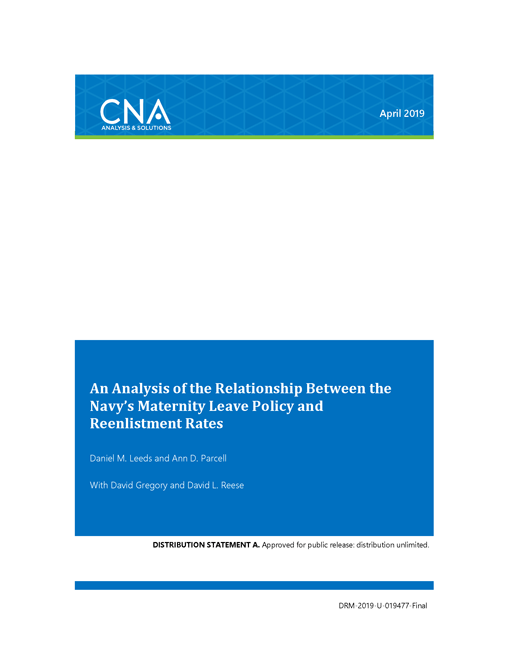Prior to 2015, the Navy provided 6 weeks of paid maternity (convalescent) leave to active component female sailors to be taken consecutively immediately after the birth of the child. Over an 8-month period in 2015 and 2016, the Navy announced two changes to the amount of leave that could be taken: an increase to 18 weeks (to be used over the child’s first year) and then a cutback to 12 weeks (to be taken consecutively immediately after the birth of the child). Additional maternity leave taken by sailors who give birth decreases the amount of work that they perform at their commands. Yet, if sailors—particularly female sailors—view the increase in leave positively, it could improve reenlistment rates. The additional weeks of work created by higher reenlistment rates could offset the weeks of work lost by those who use additional maternity leave. Higher reenlistment rates could also reduce recruiting and training costs.
Current research does not shed light on how sailors might react to additional maternity leave. To our knowledge, the relationship between maternity leave and retention in the Navy has not been analyzed. Moreover, research on civilian maternity leave is sparse and has limited applicability to the military. The impact of providing (additional) paid maternity leave has not been widely studied in a domestic context in the United States because only a handful of states provide it—and most of those only recently. Furthermore, military service obligations mean that, in many cases, sailors must return to their employer, whereas civilian employees may or may not be obligated to do so. Studies evaluating civilian employment continuity, therefore, may provide helpful context, but they may not be directly applicable to the Navy workforce.
Though offering additional leave should not affect whether sailors who give birth return to their positions, these additional benefits may increase female sailors’ likelihood of reenlisting. This could apply both to sailors who have used maternity leave (e.g., additional leave may make them feel better about the Navy as an employer) and to those who believe that they might someday use such leave (e.g., it reduces perceived conflicts between motherhood and active service). Additional maternity leave could also affect women in general by demonstrating a broader commitment to workplace issues that specifically affect female sailors. Our evaluation of the change in maternity leave policy aimed to answer three questions:
1. Did female sailors take additional maternity leave when it was offered?
2. Is the change in maternity leave policy statistically associated with changes in reenlistment rates of female sailors?
3. What is the estimated net effect of the policy change on weeks of work?
We accomplished our first goal by merging Defense Health Agency (DHA) medical claim data containing information on births to sailors between May 2011 and September 2016 with data from the Navy’s electronic leave (e-leave) system from April 2011 through September 2017. The merged data allowed us to observe leave taken 30 days before and up to 365 days after sailors gave birth.
We addressed our second goal using enlisted personnel records to compare female and male reenlistment rates before and after the longer maternity leave policy went into effect. Our particular focus is on the reenlistment behavior of sailors with four-year obligations (4YOs). We analyzed the gender differences in reenlistment rates before and after the policy change separately for female sailors with and without children because the two groups have different reenlistment patterns and may react differently to the increase in maternity leave. We accomplished our third goal by contrasting the additional weeks worked for the military through higher female reenlistment rates with the lower number of weeks worked from taking maternity leave.
We found the following:
The amount of maternity leave taken in the first year after birth increased substantially for women who gave birth on or after January 1, 2015, the retroactive implementation date of the 18-week maternity leave expansion.
After the expansion of maternity leave, we estimate that female sailors’ reenlistment rates increased by 3.7 percentage points relative to those of male sailors. The estimated increase in reenlistment rates is driven by women who did not have children as of their first soft end of active obligated service (SEAOS).
At average reenlistment lengths, many more weeks of work are gained because of increased reenlistment rates than are lost because of the increase in maternity leave. Therefore, while working weeks are lost due to additional maternity leave, increases in reenlistment more than offset these losses. Our results suggest that this more likely reflects forward-looking decisions by female sailors without children than backward-looking decisions by female sailors with children. For example, the additional leave may provide some additional assurance to female sailors who do not yet have children that a multiyear service obligation is compatible with having a family
Download reportDISTRIBUTION STATEMENT A. Approved for public release: distribution unlimited. Public Release. 4/17/2019
Details
- Pages: 58
- Document Number: DRM-2019-U-019477-Final
- Publication Date: 5/17/2019
